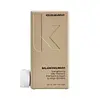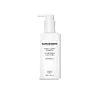What's inside
What's inside
 Key Ingredients
Key Ingredients

 Benefits
Benefits

 Concerns
Concerns

 Ingredients Side-by-side
Ingredients Side-by-side

Water
Skin ConditioningSodium Cocoyl Isethionate
CleansingCocamidopropylamine Oxide
CleansingCocamidopropyl Hydroxysultaine
CleansingGlycol Distearate
EmollientHydrolyzed Wheat Protein
Skin ConditioningPanthenol
Skin ConditioningHydrolyzed Soy Protein
HumectantHydrolyzed Vegetable Protein
Skin ConditioningWheat Amino Acids
Skin ConditioningTocopheryl Acetate
AntioxidantGuar Hydroxypropyltrimonium Chloride
Skin ConditioningPEG-150 Distearate
EmulsifyingPolyquaternium-7
Polyquaternium-11
Polyamide-2
PEG-4 Rapeseedamide
Sodium Lauroyl Sarcosinate
CleansingDecyl Glucoside
CleansingMethyl Gluceth-20
HumectantGlycereth-26
HumectantCamellia Sinensis Leaf Extract
AntimicrobialHydrolyzed Grape Fruit Extract
HumectantUrtica Dioica Extract
AstringentSalvia Officinalis Extract
AntimicrobialCinnamidopropyltrimonium Chloride
Butylene Glycol
HumectantHelianthus Annuus Seed Extract
Skin ConditioningSuperoxide Dismutase
AntioxidantMelanin
Skin ProtectingAscorbic Acid
AntioxidantLactic Acid
BufferingMalic Acid
BufferingPhenoxyethanol
PreservativeEthylhexylglycerin
Skin ConditioningParfum
MaskingBenzyl Benzoate
AntimicrobialBenzyl Salicylate
PerfumingCitronellol
PerfumingLinalool
PerfumingWater, Sodium Cocoyl Isethionate, Cocamidopropylamine Oxide, Cocamidopropyl Hydroxysultaine, Glycol Distearate, Hydrolyzed Wheat Protein, Panthenol, Hydrolyzed Soy Protein, Hydrolyzed Vegetable Protein, Wheat Amino Acids, Tocopheryl Acetate, Guar Hydroxypropyltrimonium Chloride, PEG-150 Distearate, Polyquaternium-7, Polyquaternium-11, Polyamide-2, PEG-4 Rapeseedamide, Sodium Lauroyl Sarcosinate, Decyl Glucoside, Methyl Gluceth-20, Glycereth-26, Camellia Sinensis Leaf Extract, Hydrolyzed Grape Fruit Extract, Urtica Dioica Extract, Salvia Officinalis Extract, Cinnamidopropyltrimonium Chloride, Butylene Glycol, Helianthus Annuus Seed Extract, Superoxide Dismutase, Melanin, Ascorbic Acid, Lactic Acid, Malic Acid, Phenoxyethanol, Ethylhexylglycerin, Parfum, Benzyl Benzoate, Benzyl Salicylate, Citronellol, Linalool
Water
Skin ConditioningDisodium Laureth Sulfosuccinate
CleansingSodium Cocoyl Isethionate
CleansingCocamidopropyl Betaine
CleansingPEG-4 Rapeseedamide
Acrylates Copolymer
Glycol Distearate
EmollientSteareth-4
EmulsifyingSodium Lauroyl Sarcosinate
CleansingCocamidopropyl Hydroxysultaine
CleansingParfum
MaskingCocamidopropylamine Oxide
CleansingSodium Methyl 2-Sulfolaurate
CleansingDisodium 2-Sulfolaurate
CleansingSodium Lauryl Sulfoacetate
CleansingDecyl Glucoside
CleansingPEG-7 Glyceryl Cocoate
EmulsifyingSodium Chloride
MaskingGuar Hydroxypropyltrimonium Chloride
Skin ConditioningPPG-3 Benzyl Ether Myristate
EmollientCitric Acid
BufferingPEG-150 Pentaerythrityl Tetrastearate
EmulsifyingPEG-6 Caprylic/Capric Glycerides
EmulsifyingPhenoxyethanol
PreservativeBenzyl Alcohol
PerfumingGlycerin
HumectantAmodimethicone
Sodium Hydroxide
BufferingPotassium Sorbate
PreservativeDisodium EDTA
Hydrolyzed Soy Protein
HumectantPolysorbate 20
EmulsifyingAlpha-Isomethyl Ionone
PerfumingPanthenol
Skin ConditioningLinalool
PerfumingLimonene
PerfumingC11-15 Pareth-7
EmulsifyingTrideceth-12
EmulsifyingBenzoic Acid
MaskingCinnamidopropyltrimonium Chloride
Hydrolyzed Vegetable Protein Pg-Propyl Silanetriol
Skin ConditioningLaureth-9
EmulsifyingOctadecyl Di-T-Butyl-4-Hydroxyhydrocinnamate
AntioxidantPolyquaternium-11
Tocopherol
AntioxidantChamomilla Recutita Leaf Extract
MaskingPassiflora Incarnata Extract
AstringentRosa Canina Leaf Extract
Skin ConditioningSilybum Marianum Seed Extract
Skin ConditioningWater, Disodium Laureth Sulfosuccinate, Sodium Cocoyl Isethionate, Cocamidopropyl Betaine, PEG-4 Rapeseedamide, Acrylates Copolymer, Glycol Distearate, Steareth-4, Sodium Lauroyl Sarcosinate, Cocamidopropyl Hydroxysultaine, Parfum, Cocamidopropylamine Oxide, Sodium Methyl 2-Sulfolaurate, Disodium 2-Sulfolaurate, Sodium Lauryl Sulfoacetate, Decyl Glucoside, PEG-7 Glyceryl Cocoate, Sodium Chloride, Guar Hydroxypropyltrimonium Chloride, PPG-3 Benzyl Ether Myristate, Citric Acid, PEG-150 Pentaerythrityl Tetrastearate, PEG-6 Caprylic/Capric Glycerides, Phenoxyethanol, Benzyl Alcohol, Glycerin, Amodimethicone, Sodium Hydroxide, Potassium Sorbate, Disodium EDTA, Hydrolyzed Soy Protein, Polysorbate 20, Alpha-Isomethyl Ionone, Panthenol, Linalool, Limonene, C11-15 Pareth-7, Trideceth-12, Benzoic Acid, Cinnamidopropyltrimonium Chloride, Hydrolyzed Vegetable Protein Pg-Propyl Silanetriol, Laureth-9, Octadecyl Di-T-Butyl-4-Hydroxyhydrocinnamate, Polyquaternium-11, Tocopherol, Chamomilla Recutita Leaf Extract, Passiflora Incarnata Extract, Rosa Canina Leaf Extract, Silybum Marianum Seed Extract
Ingredients Explained
These ingredients are found in both products.
Ingredients higher up in an ingredient list are typically present in a larger amount.
We don't have a description for Cinnamidopropyltrimonium Chloride yet.
Cocamidopropyl Hydroxysultaine is a synthetic cleansing agent, though it is derived from coconut oil.
It is used to enhance the texture of products by boosting lather and thickening the texture. As a cleanser, Cocamidopropyl Hydroxysultaine is mild.
We don't have a description for Cocamidopropylamine Oxide yet.
Decyl Glucoside is a glucose-based surfactant and emulsion stabilizer. It is created by reacting glucose with the fatty acids from plants.
Surfactants help clean the skin by trapping oil, sebum, and dirt to be washed away. As an emulsion stabilizer, it stabilizes the ingredients in a product by preventing them from separating.
This ingredient is biodegradable and non-toxic. This ingredient is commonly found in baby shampoos.
Decyl Glucoside is sometimes used to stabilize the UV filter Tinosorb.
Learn more about Decyl GlucosideGlycol Distearate serves as a pearlizing or opacifying agent in cosmetic products.
It's often included in cleansers and haircare products to give them a lustrous or shimmering appearance.
It is derived from stearic acid, a natural fatty acid commonly found in vegetable oils and animal fats.
Glycol Distearate isn't fungal acne safe.
Learn more about Glycol DistearateThis ingredient is derived from guar gum.
It is a conditioning ingredient, meaning it helps soften skin and hair.
Hydrolyzed Soy Protein is a vegan protein made to mimic hydrolyzed collagen. It is created from soy, or glycine soja.
This ingredient is a humectant, meaning it helps hydrate the skin by binding to water. According to a manufacturer, it is also a great hair conditioner.
Read more about hydrolyzed collagen here.
Learn more about Hydrolyzed Soy ProteinLinalool is a fragrance and helps add scent to products. It's derived from common plants such as cinnamon, mint, citrus, and lavender.
Like Limonene, this ingredient oxidizes when exposed to air. Oxidized linalool can cause allergies and skin sensitivity.
This ingredient has a scent that is floral, spicy tropical, and citrus-like.
Learn more about LinaloolPanthenol is a common ingredient that helps hydrate and soothe the skin. It is found naturally in our skin and hair.
There are two forms of panthenol: D and L.
D-panthenol is also known as dexpanthenol. Most cosmetics use dexpanthenol or a mixture of D and L-panthenol.
Panthenol is famous due to its ability to go deeper into the skin's layers. Using this ingredient has numerous pros (and no cons):
Like hyaluronic acid, panthenol is a humectant. Humectants are able to bind and hold large amounts of water to keep skin hydrated.
This ingredient works well for wound healing. It works by increasing tissue in the wound and helps close open wounds.
Once oxidized, panthenol converts to pantothenic acid. Panthothenic acid is found in all living cells.
This ingredient is also referred to as pro-vitamin B5.
Learn more about PanthenolParfum is a catch-all term for an ingredient or more that is used to give a scent to products.
Also called "fragrance", this ingredient can be a blend of hundreds of chemicals or plant oils. This means every product with "fragrance" or "parfum" in the ingredients list is a different mixture.
For instance, Habanolide is a proprietary trade name for a specific aroma chemical. When used as a fragrance ingredient in cosmetics, most aroma chemicals fall under the broad labeling category of “FRAGRANCE” or “PARFUM” according to EU and US regulations.
The term 'parfum' or 'fragrance' is not regulated in many countries. In many cases, it is up to the brand to define this term.
For instance, many brands choose to label themselves as "fragrance-free" because they are not using synthetic fragrances. However, their products may still contain ingredients such as essential oils that are considered a fragrance by INCI standards.
One example is Calendula flower extract. Calendula is an essential oil that still imparts a scent or 'fragrance'.
Depending on the blend, the ingredients in the mixture can cause allergies and sensitivities on the skin. Some ingredients that are known EU allergens include linalool and citronellol.
Parfum can also be used to mask or cover an unpleasant scent.
The bottom line is: not all fragrances/parfum/ingredients are created equally. If you are worried about fragrances, we recommend taking a closer look at an ingredient. And of course, we always recommend speaking with a professional.
Learn more about ParfumPEG-4 Rapeseedamide isn't fungal acne safe.
Phenoxyethanol is a preservative that has germicide, antimicrobial, and aromatic properties. Studies show that phenoxyethanol can prevent microbial growth. By itself, it has a scent that is similar to that of a rose.
It's often used in formulations along with Caprylyl Glycol to preserve the shelf life of products.
We don't have a description for Polyquaternium-11 yet.
Sodium cocoyl isethionate is a natural ingredient from coconut oil. It is an ultra gentle cleanser that gives a nice foam without drying the skin or impacting the skin barrier.
The amount of foam created depends on the amount of sodium cocoyl isethionate used in the product.
This ingredient also helps improve the spreadability of a product.
Learn more about Sodium Cocoyl IsethionateSodium Lauroyl Sarcosinate is a cleansing agent and emulsifier. It is a surfactant derived from sarcosine, and a common source is coconut oil.
As a surfactant, Sodium Lauroyl Sarcosinate helps lift dirts, oil, and other molecules to be washed away. In leave-on products, this ingredient is used as an emulsifier. Emulsifier help prevent ingredients such as oils and waters from separating.
Sodium Lauroyl Sarcosinate is also commonly found as a foaming agent in shampoo, toothpaste, and shaving foam. It is amphiphilic, meaning it loves both water and fats.
Learn more about Sodium Lauroyl SarcosinateWater. It's the most common cosmetic ingredient of all. You'll usually see it at the top of ingredient lists, meaning that it makes up the largest part of the product.
So why is it so popular? Water most often acts as a solvent - this means that it helps dissolve other ingredients into the formulation.
You'll also recognize water as that liquid we all need to stay alive. If you see this, drink a glass of water. Stay hydrated!
Learn more about Water